Sheepshead Bay, Brooklyn, is a small fishing village without the New England atmosphere affected by City Island in the Bronx. Its rows of boats lining Emmons Ave., taking amateur fishermen and seadogs out to the Atlantic in search of bluefish and crabs, add to the ambience. In the late-1800s and for a few more decades, Sheepshead Bay, with its neighbors, Manhattan Beach and Oriental Beach, attracted summer vacationers and later, residents. Victorian seaside hotels, the Sea Beach Palace and the Manhattan Beach Hotel, gave their names to the steam railroads that brought Brooklynites to their doors. (Another hotel, the Van Sicklen, had a station on the Culver Line named for it, but it was renamed Neptune Ave., after the nearest avenue, in the 1990s). After the Sheepshead Bay racetrack (which became an auto racing track after betting on horses was temporarily outlawed) closed, streets were cut through and residential housing filled in. The Belt Parkway attracted new residents when it reached the area in 1941, but it also served to sever the waterfront from the rest of the neighborhood. The Emmons Ave. waterfront featured Lundy’s Restaurant, Pip’s Comedy Club, Roll and Roaster and some bait and tackle shops, but most of its grand old mansions are gone. The sheepshead fish for which the bay was named no longer inhabits it.
Spanning Sheepshead Bay just west of Ocean Ave. is a weird, wooden bridge with a low fence that looks as if you could easily jump over it into the bay, or even get knocked over if sufficiently jostled. The bridge has an old pedigree: it was first opened by Long Island Rail Road king Austin Corbin in 1880, and after a few false starts (Corbin kept closing the bridge since he thought “undesirables” would frequent his development, then-exclusive Manhattan Beach) there has been a pedestrian bridge here almost continuously. It’s called the Ocean Avenue Bridge, even though it’s a block west of Ocean Ave. on the north side.
You can still get a ticket for riding a bicycle across the bridge; one time, as I was crossing, I discovered one of the wooden rail sections missing, making a dip in the bay a real possibility for the unwary. However, all is now well as the bridge was recently renovated, with new fencing and new wood planks on the walkway. The bridge was formerly lit by mini-versions of the old Belt Parkway “woodie” poles; faux bishop crook fixtures were installed in the late-1990s.
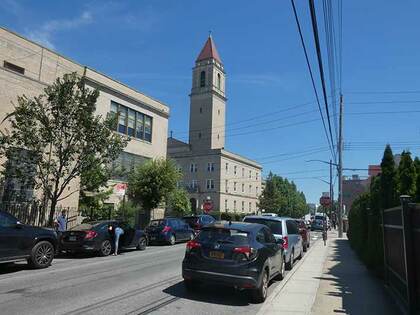
In Sheepshead Bay, Jerome Ave., which runs between Sheepshead Bay Rd. and Ave. Z at E. 23rd St., was originally an unnamed road between farms, later called Voorhies La., but after the Sheepshead Bay Racetrack, a.k.a. the Coney Island Jockey Club and Race Course was constructed in the early-1880s, the road took the name of one of its most prominent backers, Leonard Jerome. Jerome Ave. then formed the southern end of the racetrack. In 1910 betting on the ponies was outlawed in NY State (it was legalized again later) and all three area racetracks closed; housing and streets were laid out and no trace of them remains today… except for Jerome Ave.. Leonard Jerome became the grandfather of one of Britain’s pre-eminent statesmen after his daughter, Jeannette “Jenny” Jerome married Britain’s Lord Randolph Churchill; one of their two children was World War II Prime Minister Winston Churchill.
Jennie Jerome, born at a Jerome residence at 197 Amity St. in Cobble Hill, Brooklyn, worked as a magazine editor in an age when few “respectable” women worked, and had a tattoo of a snake around her left wrist. There are persistent rumors that she had some Iroquois blood, but no Native-American ancestry has been found despite the best efforts of genealogists.
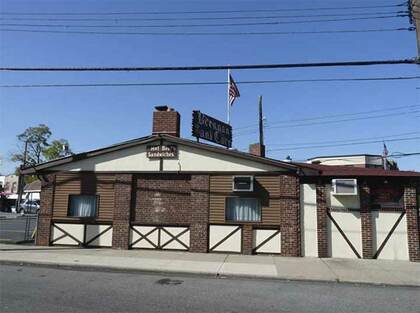
Brennan and Carr was founded in 1938 at Gravesend Neck Rd. and Nostrand Ave. and has sold roast beef sandwiches from the beginning. It’s famed for its heaping sandwiches au jus, served with fries and other sides. For years, its combo burger/roast beef sandwich (the Gargiulo Burger) was a secret item known only to regulars. Its hot dogs and desserts such as blueberry pie a la mode are highly rated. Though it has a popular takeout window, it’s a sit-down restaurant with white-coated waiters (as opposed to its opponent in the Sheepshead Bay Roast Beef Wars, Roll n Roaster on Emmons Ave., which has a fast food vibe). You can eat heartily at B & C for $20 or less (though recent inflation may have made that moot).
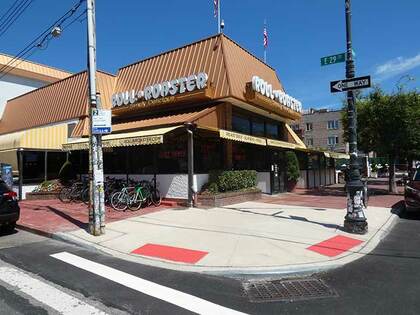
Roll n Roaster, one of three area restaurants not named Arby’s that are famed for roast beef sandwiches, has held down the NE corner of Emmons and East 29th since 1971, when it was founded by restaurateur Buddy Lamonica. For most of its existence, this has been Roll n Roaster’s sole location; a second restaurant in the East Village in the 1990s failed to catch on. Like most diners it has a fairly large menu, but most come for the roast beef sandwich served with gravy (really jus) and Cheez (as in Cheez Whiz). Roll n Roaster orders are cooked fresh after the order is made at the front counter, and hence, the food comes “not so fast.”
I’m not a big roast beef fan unless it comes with plenty of thick gravy and pepper, but I do like the large, juicy burgers that are cooked medium, with some pink showing. I like the onion rings better than the French fries, which are disk-shaped, cut thin and occasionally overdone, so they come out more like potato chips. Nathan’s remains the undisputed fries champion in these parts.
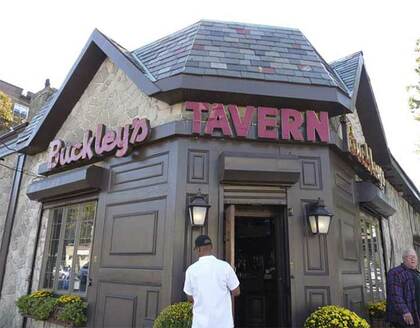
At Nostrand Ave. and Ave. S you pass Buckley’s Tavern, another Sheepshead Bay institution, and the third place I encountered today where the roast beef is recommended. Their website is bare-bones, providing no historical information, but I’ve attended two wedding receptions here as well as a 95th birthday party a few years ago.

The magnificent mismatched steeples of the Sheepshead Bay United Methodist Church at the SE corner of Ocean and Voorhies Aves. are still standing. The congregation dates back to 1841, with this building erected in 1869 (with a 1925 renovation). In 2011 the steeples were in precarious shape and about to be razed, but a last-ditch attempt has stabilized them for now. Services are held in English and in Korean for a small but loyal congregation.
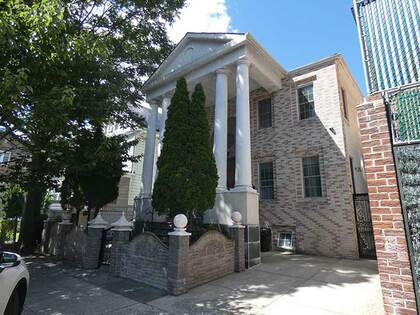
This mini-Parthenon, on 1811 Voorhies east of Sheepshead Bay Rd., became rundown over the decades and by the 1990s was known as Sheepshead Bay’s Hell House. The building was home to early-1900s cartoonist Winsor McCay, the creator of Little Nemo in Slumberland. It was in danger of being torn down or converted to a homeless shelter, but fortunately it still exists, albeit with a questionable modern makeover.
For those unfamiliar with Little Nemo, Tom Petty’s 1988 video for “Runnin’ Down a Dream” was a tribute of sorts to McCay’s artwork.

On a somber note, the center mall at Shore Blvd., just south of Emmons and Neptune Aves., is the site of the only memorial park in NYC remembering the Holocaust. It was dedicated in 1985.
—Kevin Walsh is the webmaster of the award-winning website Forgotten NY, and the author of the books Forgotten New York (HarperCollins, 2006) and also, with the Greater Astoria Historical Society, Forgotten Queens (Arcadia, 2013)

